

Starting Minibus Transport Business Plan (PDF)

Minibuses play a very important role in the public transport industry. Everyday millions of people use minibuses as transport to get to their destinations. Minibus public transport business is a very lucrative venture, which is highly rewarding. This article will outline how to start the minibus public transport business, and the minibus business plan – PDF, Word and Excel.
Minibus public transportation is a lucrative business, providing income for millions of people, but there are some essential decisions you need to make before you venture into the business. You have to make a decision on how many minibuses you will start with, the type of minibuses, the routes you will be operating in, and your target market. These choices will be affected by the amount of capital you have, and the opportunities available in the market. If you do not have a lot of capital, you can always start small and grow your minibus public transport business overtime.
Size is not everything in the minibus public transport industry – you do not need a large fleet in order to start up the minibus business. There are stories of people who have started a successful public transport business with nothing more than a single minibus. At the same time, the public transport business industry is diverse and rich enough to accommodate very large companies with large fleets of minibuses. Whatever option you choose; there are some critical issues that you must take into consideration as you come up with your minibus business plan.
Market Research
Formidable competition to contend with.
In many parts of the world there are affordable and reliable public transportation systems. This can be in the form of trains, and buses, amongst others; typically run by government. This is serious competition for a minibus transport business. No wonder you need to conduct market research. You have to figure out your competition i.e. government-run and private public transportation providers.
Seeking To Find A Disruptor Element
You want to know the routes they cover, their fare structures, and the type of transportation they use. People tend to be loyal to certain public transporters. Your market research is to find gaps and loopholes you can leverage on to be more appealing. After all, minibuses are not typical in many parts of the world. Thus you really have to dig deep to understand the public transport dynamics of your target market. That brings to the fore the target market.
Figuring Which Target Market Is Ideal
You want to figure which markets are worth targeting and how. It could be plying a particular route daily. It might be for companies, schools, and the like i.e. daily transportation of staff or students. You could find underserved routes and cater for them. Another niche is hiring out your minibus for intracity or intercity trips. Being able to know how exactly you must package your value proposition requires in-depth market research. Minibuses are atypical so you cannot just assume, be empirical!
Even though your business will be transporting people on the road; you still need some sort of premises for your minibus transport business. You can lease an office in the beginning of your business and then purchase your own later on. The office will have to be furnished and you have to hire employees to manage the office work. The work of the office is vital to the rest of the business. You should not treat it like a separate entity which does not need to conform to the highest standards of customer care. Instead try to ensure that you have a seamless service provision that is uniformly impressive and excellent. You also need secure premises where your minibuses will be parked when not on the road. The minibus business plan should cater for funds to purchase or lease premises.
Vehicles and Equipment
You need to purchase minibus vehicles in order to start the public transport business. The minibus vehicles can be imported from other countries where they are cheap or you can buy them locally from your country. The number and type of minibuses required will depend on the amount of capital which you have and your target market. You will also have to make a decision on whether to buy brand new minibus vehicles or second hand vehicles. When starting the business with limited capital, it maybe better to purchase used minibus vehicles. The advantage of having new minibus vehicles is that you will have lower maintenance costs and better reliability on the road.
There are several factors to take into consideration when purchasing the minibus vehicles. Some of the factors include: purchase price, fuel consumption, transmission mode (automatic vs manual), passenger capacity, model, new minibus vs used minibus. If you have limited capital, you can always start your minibus public transport business with just one vehicle. Minibus public transportation business is very profitable and if you reinvest your profits, you will be able to purchase more minibuses.
Equipment required for the minibus business include garage equipment and repair tools. The minibus drivers should always travel with basic repair tools such that if they encounter minor problems along the way, they can always fix the vehicles. The minibus business plan should include the costs of purchasing the vehicles and equipment.
Minibus Servicing And Repairs
Aim is to be always reliable and efficient.
The success of being a public transportation provider heavily depends on your efficiency and reliability. People will prefer your minibuses if they operate efficiently. Breakdowns or poor vehicle performance will put off customers. After all, people already have so many other options they can turn to. That is why you cannot afford to have minibuses that are unreliable. You have to regularly service your minibus as prescribed.
Stick To A Regular Servicing Schedule
The servicing schedule might differ depending on the type of minibus. At times it can be premised on certain mileage milestones. A general rule is that services should not be spaced by more than 10 weeks. Thus in a year, your minibus must be serviced at least 5 times. Sticking to this servicing regiment keeps the minibus operating efficiently. It helps you detect early any issues requiring attention. The need for repairs is significantly reduced or even eliminated just by regular servicing.
Inevitability Of Repairs And The Need For Professional Hands
A minibus has several moving parts – electrical, electronic, mechanical, and so on. Faults can happen which necessitate repairs. When that happens it is prudent to involve qualified and skilled professionals. Maybe you do it in-house or you engage a repairs provider. Whichever the case is, you must ensure that repairs are done professionally; no shortcuts. Improperly done repairs lead to more complications and can shorten the lifespan of the minibus. Plus your minibus transport business will be severely compromised.
Minibus Public Transport Business Insurance and Licences
One of the critical requirements that can potentially have catastrophic consequences for the public as well as the business is insurance. It is advisable to have a comprehensive insurance plan for all the minibus vehicles. The costs of comprehensive insurance are more than offset by the potential losses if you were to have an accident. As a business; the minibus business may be liable for very significant punitive damages particularly if there is a loss of life. Without adequate insurance, the minibus public transport business could be bankrupted by compensation claims.
The minibus public transport industry is regulated and the specific licences depends with the country. First of all, your drivers must be properly licensed with up to date records including health checks and driver licences. Your local council will have a list of regulatory requirements which must be diligently followed lest you lose your license to operate the minibus business. The minibus public transportation business plan should include costs for the insurance and licenses.

Staff and Management
Operations staff is a necessity for the minibus public transport business. Operations staff are responsible for handling the operations of the public transport business. They include drivers, conductors, logistics personnel, mechanics and operations manager. You will need a minibus driver as the minimum starting employee for the minibus transport business.
Finance and accounting employees are also required. For a small minibus business, the duty can be handled by the owner of the business or a part time accountant. However as the minibus public transport business grows, there will be need for full time employees who will be responsible for the finance and accounting needs of the business. Their duties will include usual day to day transaction accounting for business, managing the cash flow of the minibus public transport business, and always ensuring the enough funds are available for the day to day needs of the minibus business.
Capital for Starting Minibus Public Transport Business
The amount of capital required for starting the minibus public transport business depends on the size of the business. It all depends on what you want to achieve and the resources that you have. When starting a minibus business, most of the capital goes to acquiring the minibus vehicles. You can get a loan from the bank, or funding from investors, to use as capital to start your minibus public transport business. If you plan to raise capital from investors and a loan from the bank, you need a good minibus public transport business plan. If you don’t have access to investors and bank loan, you can use your personal savings and start small, and grow your minibus business overtime. Minibus transport business is very profitable, so if you reinvest the profits you get, you can grow over time. Even if you are not planning to get a loan, you should still get a minibus project plan to guide you in starting and operating the business. It is essential for you to have a minibus transport business plan before you venture into the minibus business, so that you know all the costs involved and you make an informed decision.
Marketing Plan
Build a solid online presence via a business website and social media accounts. Have a framework that even allows people to book online, if applicable. While you are at it, join strategic online marketplaces or business listing platforms.
Effective Branding
Branding your minibus is a sure way of grabbing people’s attention. Engage branding companies and have it colourfully and informatively branded. Find a strategic location for an office and brand it well too. Incorporate the use of banners and posters. Put signage at strategic locations so that brand awareness is spread out.
Ad Placements
You can do ad placements through strategic platforms such as radio, print media, podcasts, online content, and the like. Consider email marketing by sending promotional material about your minibus transport business to prospects.
Market for the Minibus Transport Business
The market for minibus transport is very huge. Minibuses are an affordable means of transport which are used by many people. Minibuses are used as a form of transport for both short distance routes and long distance routes. Short distance routes include routes within the same city. On the other hand long distance routes maybe from one city to the other or cross boarder routes. Minibuses can also be used for private hire by companies, organisations, schools and individuals.
Expansion Strategies
The minibus transport business is scalable through more trips or getting more minibuses. Expansion should be informed by your minibus transport business’ performance. You can notice that you are underserving the market i.e. demand is higher. There could be more untapped markets or routes. These are both opportunities for expansion. The best way to expand is by growing your fleet. Do not rush this though; roots down first, even if it is just one minibus. It is best to wait till your revenues are now substantial and consistently sustained. This will make it easier to purchase new minibuses either directly or by use of loans.
Keys To Profitability
Niche marketing.
In marketing your minibus transport business you must use niche marketing. Niche marketing refers to concerted marketing efforts specifically channelled towards a clearly-defined segment of prospects. Remember the transport industry is immensely broad. To maximize on marketing resources, time, and energy you need to speak to the right prospects. Niche marketing considers metrics such as price, income levels, quality, interests, and geographical dynamics, amongst others.
Invest In Your Staff To Differentiate You Minibus Business
One of the biggest turnoffs for customers is poor treatment from staff. This also extends to staff not being time-conscious and driving recklessly. Invest in regular staff training or up-skilling. Satisfactorily remunerate your staff so that they do their duties happily and professionally. This is pivotal in building customer loyalty and in turn, referrals. You can further cement this by offering competitive prices.
Public transportation is a lucrative but competitive market space. Downtime should be avoided by all means if your minibus transport business is to thrive. The long term goal should be to grow your fleet. If you have just one minibus, you will hit the ceiling at some point.
Pre-Written Minibus Business Plan (PDF, Word And Excel): Comprehensive Version, Short Funding/Bank Loan Version and Automated Financial Statements
For an in-depth analysis of the minibus public transport business, we encourage you to purchase our well-researched and comprehensive minibus transport business plan. We introduced the business plans after discovering that many were venturing into the minibus transport business without enough knowledge and understanding of how to run the minibus public transport business, lack of understanding of the financial side of the business, lack of understanding of : the industry, the risks involved , costs and profitability of the business; which often leads to disastrous losses.
The StartupBiz Global minibus public transport business plan will make it easier for you to launch and run your minibus transport business successfully, fully knowing what you are going into, and what’s needed to succeed in the business. It will be easier to plan and budget as you will be aware of all the costs involved in setting up and running the minibus public transport business.
Uses of the Minibus Public Transport Business Plan (PDF, Word And Excel)
The minibus transport business plan can be used for many purposes including:
- Raising capital from investors/friends/relatives
- Applying for a bank loan
- Start-up guide to launch your minibus business
- As a minibus business proposal
- Assessing profitability of the minibus transport business
- Finding a business partner
- Assessing the initial start-up costs so that you know how much to save
- Manual for current business owners to help in business and strategy formulation
Contents of the Minibus Transport Business Plan (PDF, Word And Excel)
The minibus business plan include, but not limited to:
- Marketing Strategy
- Financial Statements (monthly cash flow projections, income statements, cash flow statements, balance sheets, break even analysis, payback period analysis, start-up costs, financial graphs, revenue and expenses, Bank Loan Amortization)
- Risk Analysis
- Industry Analysis
- Market Analysis
- SWOT & PEST Analysis
- Operational Requirements
- Operational Strategy
- Why some people in the minibus transport business fail, so that you can avoid their mistakes
- Ways to raise capital to start your minibus business
The Pre-written minibus public transport business plan package consist of 4 files
- Minibus Business Plan – PDF file (Comprehensive Version – 65 Pages)
- Minibus Transport Business Plan – Editable Word File (Comprehensive Version – 65 Pages)
- Minibus Business Plan Funding/Bank Loan Version- Editable Word File (Short version for applying for a loan/funding – 40 pages)
- Minibus Transport Business Plan Automated Financial Statements – (Editable Excel File)
The business plan can be used in any country and can be easily edited. The financial statements are automated. This implies that you can change eg the number of minibuses, number of trips per day etc, and all the other financial statements will automatically adjust to reflect the change.
Click below to download the Contents Page of the Minibus Public Transport Business Plan (PDF)

Testimonial 2
Many thanks for your incredibly efficient service and thorough business plan. I am very impressed with the business plan. Before I bought the business plan, I tried to do my own business plan – it was such a nightmare and it turned out badly, also not to mention the stress it caused me. I wish I knew about your website earlier!
Testimonial 1
StartupBiz Global provided a very professional and comprehensive business plan which I used for my business. The business plan was easy to edit, and I was able to get the funding which I wanted. I highly recommend their business plans.
Testimonial 8
Just wanted to say I am very happy with the business plan and I will gladly recommend your products, thank you very much and have a great day.
Testimonial 6
I purchased a business plan from you, and I’m glad to inform you that I was able to get my loan, and I’m starting my poultry farming business on the 1 st of July. This was made possible because of your business plan. Thank you very much, you made my dream come true.
Testimonial 3
I was extremely lucky to come across StartupBiz Global. Their business plan exceeded my expectations, and most importantly I was able to secure a loan from my bank. Thank you guys, now my dreams are coming true!
Testimonial 5
I was able to understand the business side of farming because of your business plan. You did extensive research; the business plan was well prepared and fully detailed. It made everything clear, and I have somewhere to start now. I am confident that I am going to succeed in my business because of the guidance from your business plan.
Testimonial 7
I found Startupbiz Global online when I was in desperate need of a business plan. I was overwhelmed by the quality of the business plan, it’s comprehensive and well researched! I did not have to wait to get the business plan, I got it instantly after payment. I highly recommend Startupbiz Global, and would happily use them again in the future.
Testimonial 4
The business plan which I purchased from your website saved me TIME and MONEY! The layout of the business plan was excellent. The financial statements were detailed and easy for me to edit. I will come back to purchase another business plan soon.
Get the Minibus Business Plan (PDF, Word And Excel)
Click Buy Now below to purchase using Paypal, Credit Card, or Debit Card. After you have purchased, you will immediately see the download link for the business plan package on the screen. You will also immediately get an email with the business plan download link. The Pre-written business plan package (PDF, Word, and Excel) costs $30 only!

If you want to purchase multiple business plans at once then click here: Business Plans Store.
The business plan package is a zipped compressed file containing the PDF, Word and Excel documents. To open the package after downloading it, just right click, and select Extract All. If you have any problems in downloading and opening the files, email us on [email protected] and we will assist you.
We wish you the best in your minibus business! Check out our collection of business plans , and more business ideas .
Related Posts

Profitable Poultry Farming Business Ideas

Top 9 Recycling Business Ideas

Starting Broiler Poultry Farming Business Plan (PDF)

Starting a Clothing Boutique Business Plan (PDF)
- Paragraph Generator
- Cover Letter
- Authorization Letter
- Application Letter
- Letter of Intent
- Letter of Recommendation
- Business Plan
- Incident Report
- Reference Letter
- Minutes of Meeting
- Letter of Resignation
- Excuse Letter
- Research Proposal
- Job Application
- Acknowledgement
- Employment Letter
- Promissory Note
- Business Proposal
- Statement of Purpose
- Offer Letter
- Deed of Sale
- Letter of Interest
- Power of Attorney
- Solicitation Letter
Transportation Business Plan
Transportation business plan format, transportation business plan samples, what is a transportation business plan, purposes of a transportation business plan, types of transportation business plans, how to start a transport business plan, is the transportation business profitable, is doing business risky, who can decide and oversee public transportation, how does a transportation business plan benefit startups, what role does market research play in the plan, how should financial projections be presented, what technologies are essential for a transportation business.
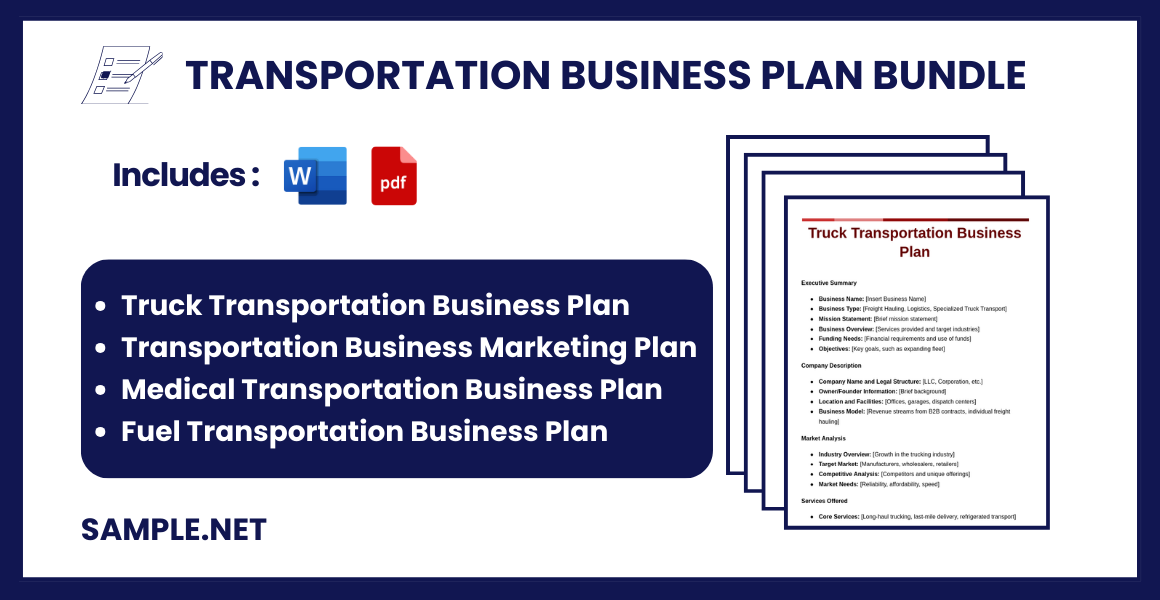
Executive Summary
- Business Name: [Insert Business Name]
- Business Type: [Freight, Passenger, Logistics, etc.]
- Mission Statement: [Brief mission statement]
- Business Overview: [A summary of services and target market]
- Funding Needs: [Overview of financial requirements and use of funds]
- Objectives: [Key short-term and long-term goals]
Company Description
- Company Name and Legal Structure: [LLC, Corporation, etc.]
- Owner/Founder Information: [Brief background]
- Location and Facilities: [Office, vehicle storage, etc.]
- Business Model: [Details on how the business will operate and generate revenue]
Market Analysis
- Industry Overview: [Trends, growth potential, challenges]
- Target Market: [Demographics, geography, and customer needs]
- Competitive Analysis: [Key competitors and your advantage over them]
- Market Needs: [Unmet demands your business will address]
Services Offered
- Core Services: [E.g., freight transport, passenger shuttle, logistics support]
- Specialized Services: [E.g., refrigerated transport, same-day delivery]
- Service Area: [Local, regional, national, or international]
Marketing and Sales Strategy
- Pricing Strategy: [Competitive pricing, premium services, etc.]
- Promotion Plan: [Advertising, partnerships, digital marketing]
- Sales Channels: [Online booking, partnerships, direct sales]
- Customer Retention: [Loyalty programs, excellent customer service]
Operational Plan
- Fleet Management: [Type and number of vehicles, maintenance strategy]
- Technology Utilized: [GPS, booking apps, fleet management systems]
- Staffing Requirements: [Drivers, dispatchers, administrative staff]
- Daily Operations: [Schedules, route planning, customer handling]
- Safety and Compliance: [Adherence to transportation regulations]
Management and Organization
- Organizational Structure: [Hierarchy or team setup]
- Key Personnel: [Backgrounds of team leaders and management]
- Roles and Responsibilities: [What each team member will do]
- Advisors/Consultants: [Legal, financial, or industry advisors]
Financial Plan
- Startup Costs: [Vehicle purchase, insurance, technology, licenses]
- Revenue Streams: [Service fees, additional charges, subscriptions]
- Projected Income Statement: [Revenue, expenses, and profit for 3-5 years]
- Cash Flow Analysis: [Monthly inflow and outflow]
- Break-even Analysis: [How long until profitability]
- Funding Requirements: [Capital needed, sources of funding]
- Licenses and Permits: [Copies of business licenses, operating permits]
- Vehicle Details: [Fleet list and specifications]
- Resumes of Key Personnel
- Market Research Data
- Additional Supporting Documents: [E.g., customer testimonials, supplier agreements]
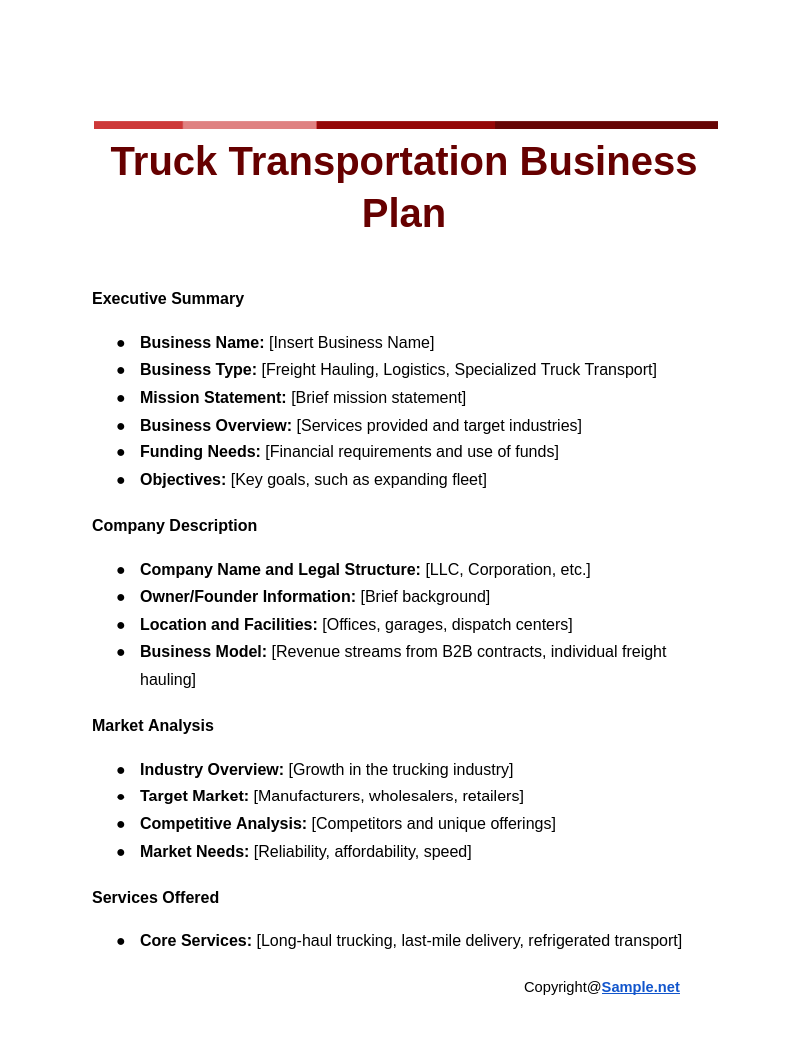
Truck Transportation Business Plan
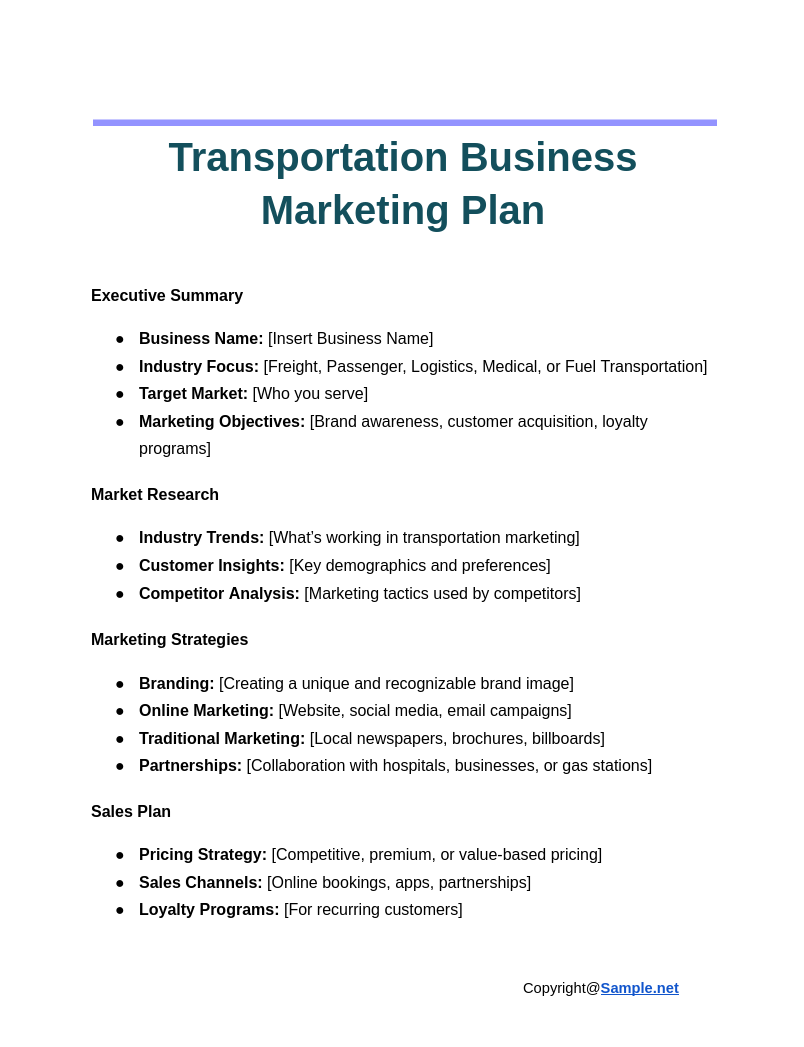
Transportation Business Marketing Plan
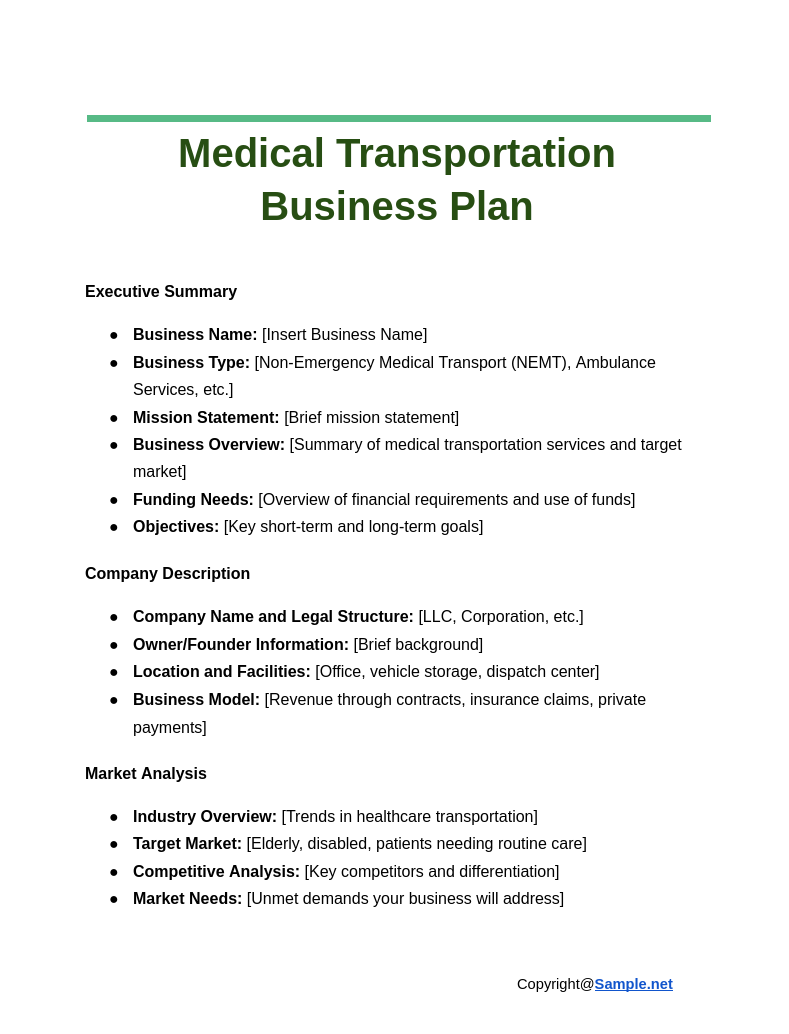
Medical Transportation Business Plan
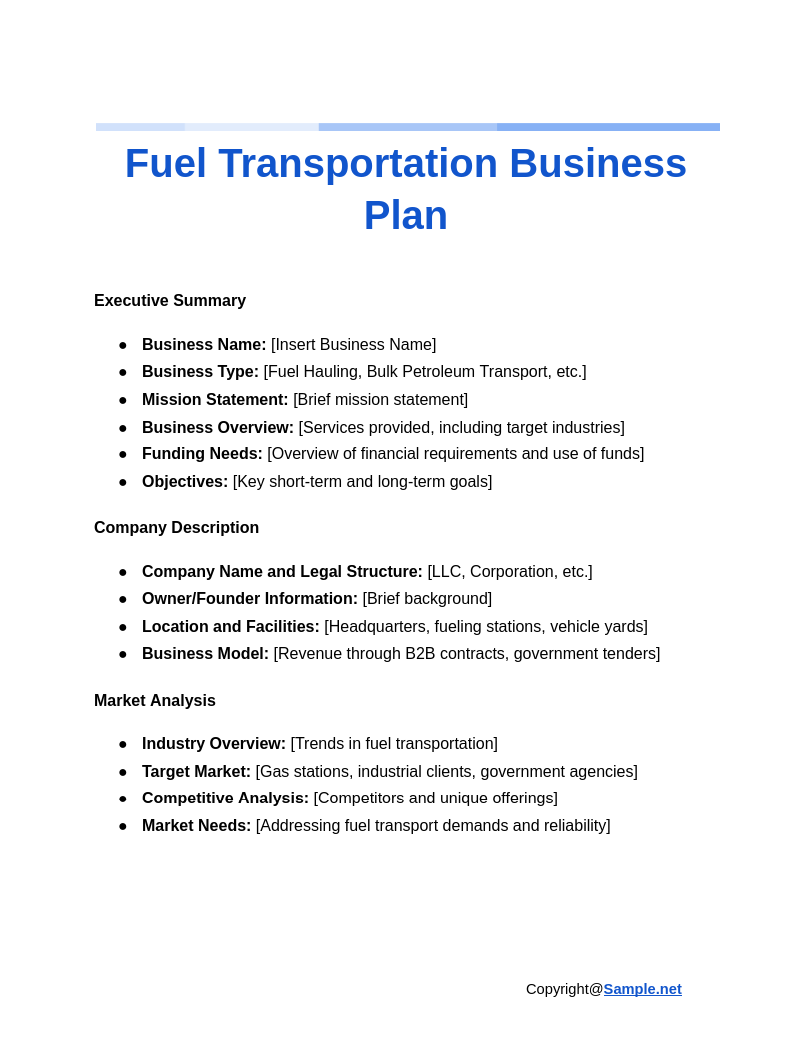
Fuel Transportation Business Plan
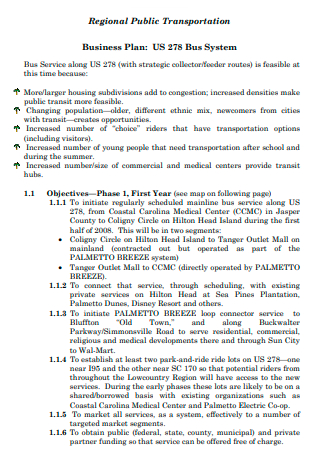
Regional Public Transportation Business Plan
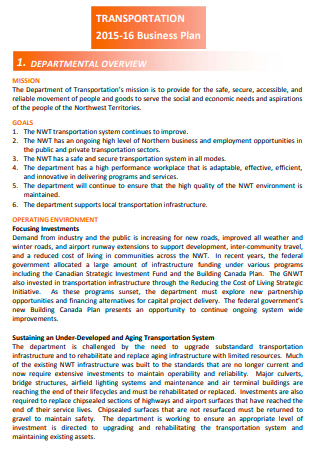
Transportation Business Plan Example
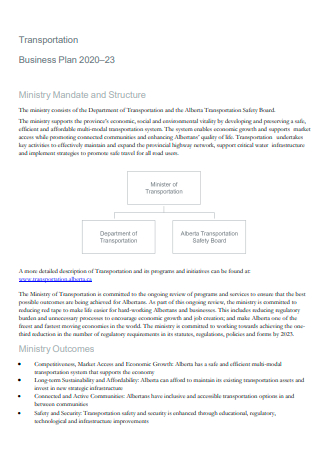
Printable Transportation Business Plan
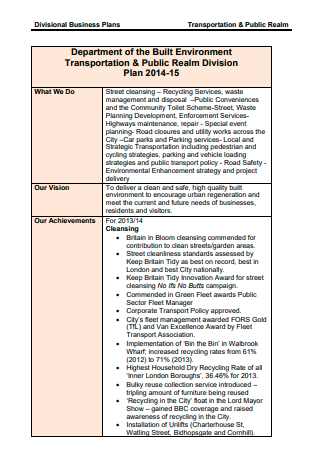
Transportation Divisional Business Plan
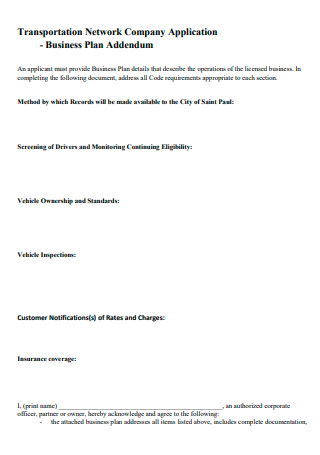
Transportation Network Company Application Business Plan
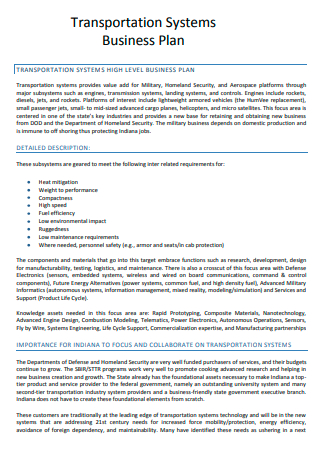
Transportation Business Plan in PDF
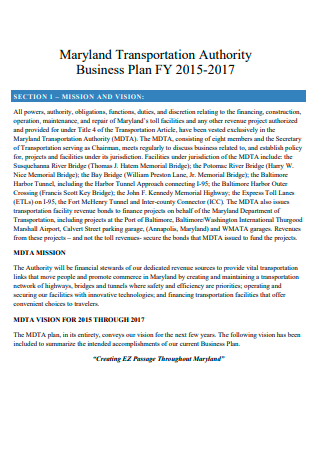
Transportation Authority Business Plan
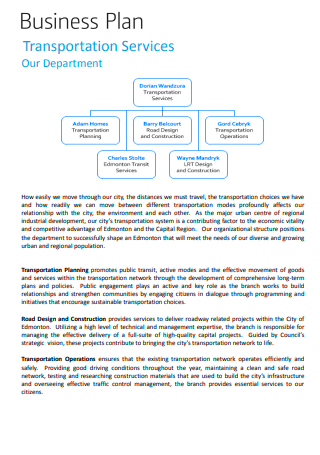
Transportation Services Business Plan
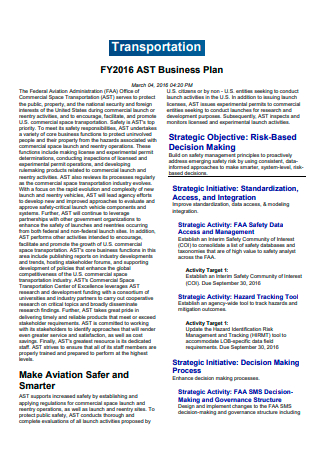

Basic Transportation Business Plan
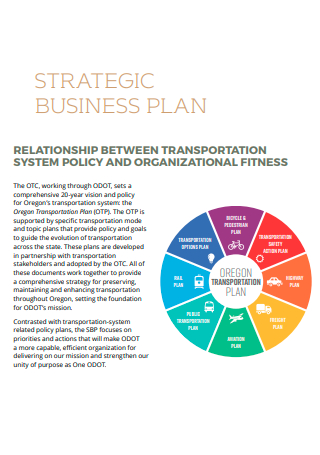
Transportation Strategic Business Plan
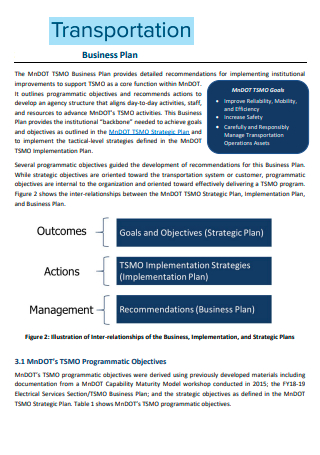
Standard Transportation Business Plan
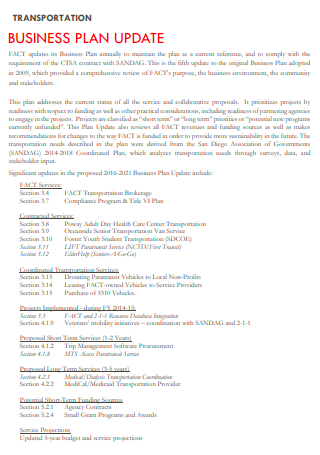
Transportation Business Plan Update
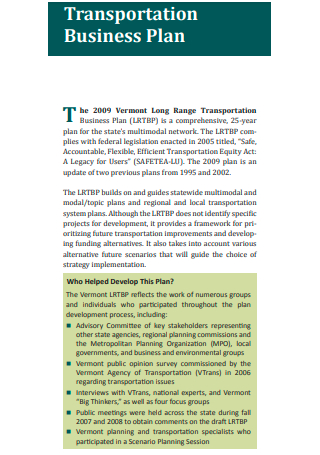
Transportation Business Plan in DOC
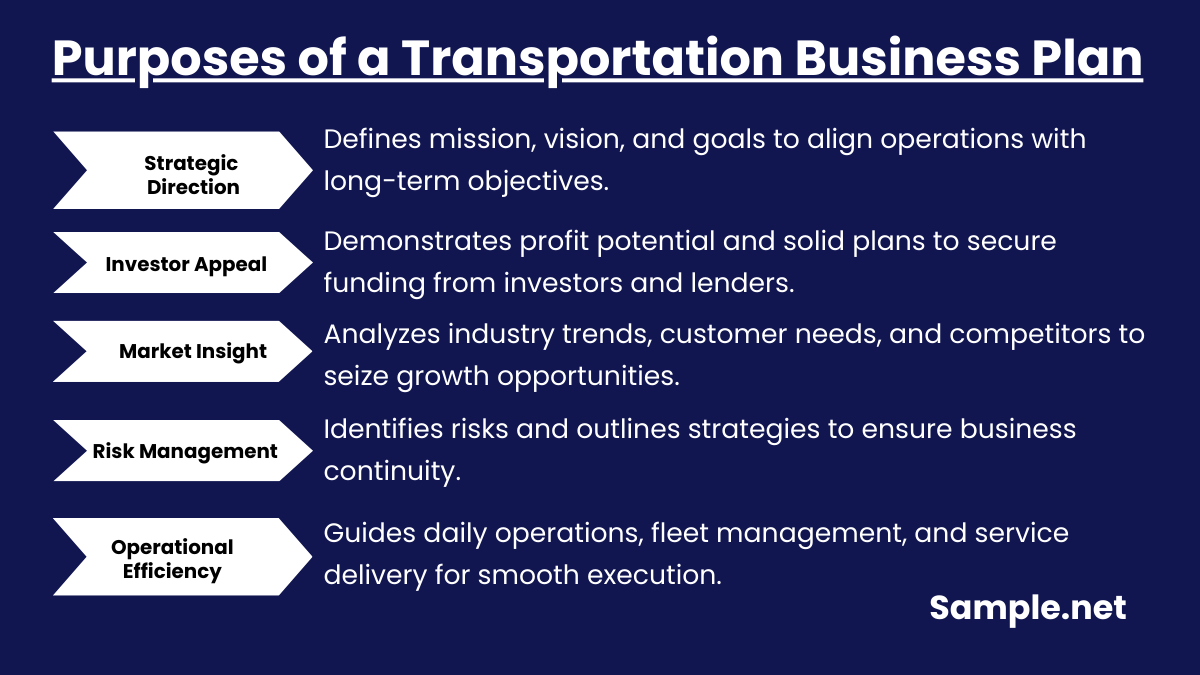
Tip 1: Determine the Goals.
Tip 2: explain your services and company., tip 3: determine the projected budget., tip 4: smoothen out the logistics., share this post on your network, you may also like these articles, school business plan.
A school business plan is a comprehensive document outlining the objectives, strategies, and operational framework for establishing or managing a school. It details the vision, target audience, financial projections,…
Boutique Business Plan
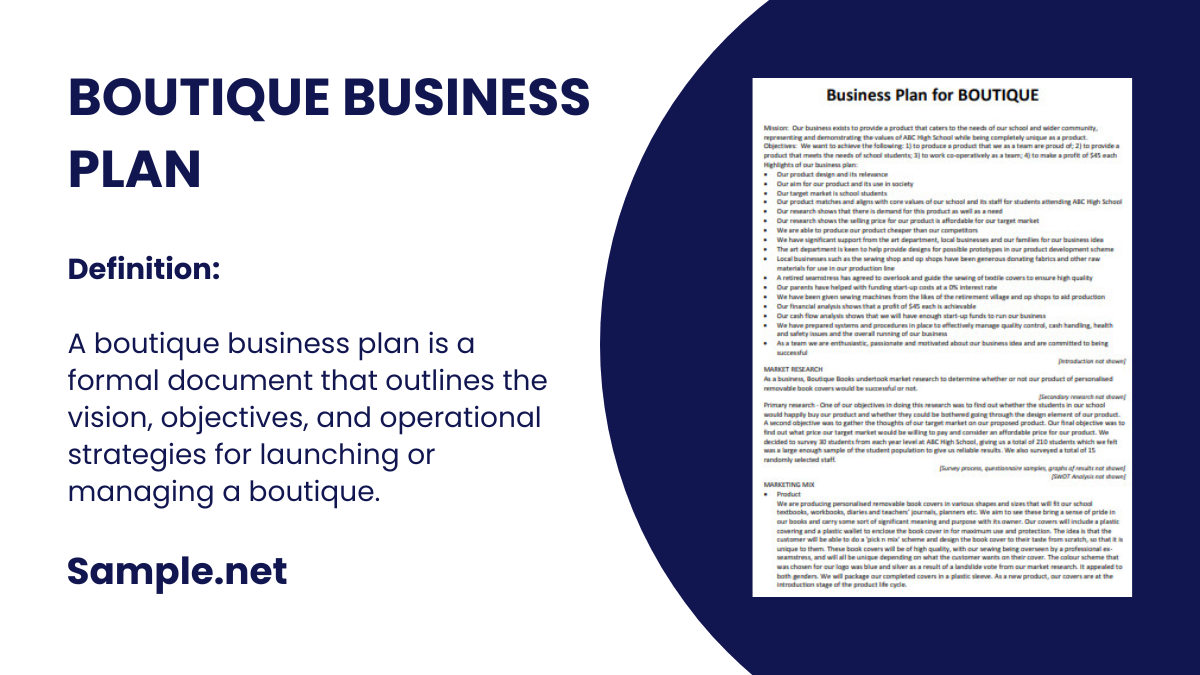
A boutique business plan is a comprehensive roadmap tailored to the unique needs of boutique owners. It outlines the business's goals, market strategies, and financial projections while capturing the…
browse by categories
- Questionnaire
- Description
- Reconciliation
- Certificate
- Spreadsheet
Information
- privacy policy
- Terms & Conditions

Item added to your cart
Download all the resources to start a transportation company.
Let's make sure your logistics firm will be profitable!
Here is a free business plan sample for a transportation company

If the open road calls to you and you envision starting your own transportation company, you've navigated to the perfect starting point.
In the content that follows, we will steer you through a comprehensive sample business plan tailored for a transportation enterprise.
As an aspiring entrepreneur, you're likely aware that a robust business plan is the roadmap to success, guiding you to establish your objectives, strategies, and financial projections.
To shift your planning into high gear with ease and precision, you can utilize our transportation company business plan template. Our specialists are also on standby to provide a complimentary review and refinement of your plan.

How to draft a great business plan for your transportation company?
A good business plan for a transportation company must reflect the unique challenges and opportunities of the logistics and transport industry.
To start, it is crucial to provide a comprehensive overview of the transportation market. This includes current statistics and the identification of emerging trends within the industry, as illustrated in our transportation business plan template .
Your business plan should clearly articulate your vision, define your target market (such as local businesses, international shippers, or e-commerce platforms), and describe your company's unique value proposition (like expedited shipping, specialized vehicle fleets, or cost-effective solutions).
Market analysis is a key component. This section should delve into the competitive landscape, regulatory environment, potential partnerships, and customer needs and expectations.
For a transportation company, it is vital to detail the services you plan to provide. This could include freight shipping, passenger transport, logistics services, or last-mile delivery. Explain how these services will meet the demands of your intended customer base.
The operational plan is critical. It should outline the logistics of your operations, including fleet management, routing and scheduling, maintenance protocols, technology use (such as GPS tracking or transportation management systems), and staffing requirements.
Quality control, adherence to transportation regulations, safety standards, and environmental considerations are also important aspects to emphasize for a transportation business.
Discuss your marketing and sales strategies. How will you build your client base and maintain customer relationships? Consider your approach to sales, pricing strategies, and the role of customer service.
Incorporating digital strategies, such as a professional website, online booking systems, and a social media presence, is increasingly important for modern transportation companies.
The financial section is another cornerstone of the plan. It should include your startup costs, revenue projections, operational expenses, and the point at which you expect to break even.
Transportation companies often deal with significant overhead costs, so precise financial planning and understanding your cash flow is essential. For assistance, refer to our financial forecast for a transportation company .
Compared to other business plans, a transportation company's plan must pay special attention to vehicle acquisition and maintenance, fuel cost management, insurance, and compliance with transportation laws and regulations.
A well-crafted business plan will not only help you clarify your strategy and operational approach but also serve as a tool to attract investors or secure loans.
Lenders and investors are looking for thorough market research, realistic financial projections, and a clear plan for day-to-day operations.
By presenting a detailed and substantiated business plan, you showcase your professionalism and dedication to the success of your transportation company.
To achieve these goals while saving time, you can start with our transportation business plan template .

A free example of business plan for a transportation company
Here, we will provide a concise and illustrative example of a business plan for a specific project.
This example aims to provide an overview of the essential components of a business plan. It is important to note that this version is only a summary. As it stands, this business plan is not sufficiently developed to support a profitability strategy or convince a bank to provide financing.
To be effective, the business plan should be significantly more detailed, including up-to-date market data, more persuasive arguments, a thorough market study, a three-year action plan, as well as detailed financial tables such as a projected income statement, projected balance sheet, cash flow budget, and break-even analysis.
All these elements have been thoroughly included by our experts in the business plan template they have designed for a transportation company .
Here, we will follow the same structure as in our business plan template.

Market Opportunity
Market data and figures.
The transportation industry is a critical component of global commerce and is experiencing significant growth.
Recent estimates value the global transportation market at approximately 7 trillion dollars, with expectations for continued expansion due to the rise in e-commerce, global trade, and technological advancements in logistics and supply chain management.
In the United States alone, there are over 500,000 transportation businesses, contributing to an annual revenue of over 1 trillion dollars for the sector.
These statistics underscore the pivotal role of transportation companies in supporting economic activity and facilitating the movement of goods across the country and internationally.
The transportation sector is witnessing several key trends that are shaping its future.
Electrification and alternative fuels are gaining traction as the industry seeks to reduce its carbon footprint and comply with environmental regulations. Electric trucks, ships, and planes are being developed and deployed to meet these goals.
Autonomous vehicles and drones are also on the rise, promising to revolutionize delivery services and enhance efficiency in logistics.
Digital transformation is another significant trend, with the integration of Internet of Things (IoT) devices, advanced tracking systems, and blockchain technology improving transparency and real-time data access.
Additionally, the demand for last-mile delivery services is surging, driven by online shopping and consumer expectations for faster delivery times.
These trends indicate a dynamic evolution in the transportation industry, with companies investing in innovation to stay competitive and meet the evolving needs of the market.
Success Factors
Several factors contribute to the success of a transportation company.
Efficiency in operations is paramount. Companies that can optimize routes, reduce transit times, and manage costs effectively are more likely to succeed.
Reliability and safety are also critical, as customers depend on timely and secure delivery of their goods.
Strategic location of hubs and networks can greatly influence a company's ability to provide comprehensive service coverage and quick response times.
Customer service excellence is essential for building trust and loyalty, especially when handling customer inquiries and resolving issues promptly.
Lastly, the ability to adapt to industry changes, such as implementing sustainable practices and embracing technological innovations, is crucial for long-term viability in the transportation sector.
The Project
Project presentation.
Our transportation company project is designed to address the increasing need for reliable, efficient, and eco-friendly transportation solutions. Strategically located to serve urban centers, business districts, and residential areas, our company will offer a diverse fleet of vehicles, including electric cars, hybrid buses, and cargo vans, all equipped with the latest technology to ensure safety and comfort.
We will prioritize punctuality, customer service, and adaptability to cater to various transportation needs, from daily commutes to corporate logistics.
Our transportation company aims to set a new standard in the industry, focusing on sustainability and customer satisfaction, and becoming a go-to provider for modern, environmentally-conscious travelers and businesses.
Value Proposition
The value proposition of our transportation company is centered on delivering top-tier transportation services that are both eco-friendly and customer-oriented.
Our commitment to using green technology and reducing carbon emissions offers a responsible choice for those who are environmentally conscious, without compromising on efficiency or convenience.
We are dedicated to enhancing the transportation experience by offering a range of services tailored to individual and corporate needs, ensuring that every journey is smooth, timely, and comfortable.
Our transportation company is poised to become a cornerstone in the community, providing a sustainable alternative to traditional transportation methods and contributing to the betterment of our environment and the quality of life of our customers.
Project Owner
The project owner is a seasoned professional with extensive experience in the transportation and logistics industry.
Armed with a deep understanding of the challenges and opportunities in modern transportation, they are committed to launching a company that stands out for its dedication to sustainability, customer satisfaction, and innovation.
With a strategic vision for reducing environmental impact and a commitment to leveraging cutting-edge technology, they are determined to offer a service that not only meets the demands of today's market but also anticipates the needs of tomorrow's world.
Their passion for excellence and their expertise in transportation make them the driving force behind this project, aiming to revolutionize the way we think about travel and logistics in an eco-friendly and customer-centric manner.
The Market Study
Market segments.
The market segments for this transportation company are diverse and cater to various customer needs.
Firstly, there are corporate clients who require reliable and professional transportation services for their employees, clients, or goods.
Secondly, individual customers seeking convenient and efficient personal transport solutions, such as airport transfers or private car services.
Another segment includes businesses that need logistics support, including freight and cargo services for their supply chain operations.
Lastly, the tourism sector can be a significant market, with services tailored to tourists needing guided tours, shuttle services, or chartered trips.
SWOT Analysis
A SWOT analysis of this transportation company project highlights several key factors.
Strengths include a diverse fleet of vehicles, experienced drivers, and a strong reputation for reliability and customer service.
Weaknesses might involve the high operational costs of vehicle maintenance and fuel, as well as the need for continuous investment in fleet upgrades.
Opportunities can be found in the expansion of services to new markets, the adoption of green technologies, and partnerships with local businesses and tourism agencies.
Threats may include fluctuating fuel prices, regulatory changes, and intense competition from both traditional and app-based transportation services.
Competitor Analysis
Competitor analysis in the transportation sector shows a highly competitive landscape.
Direct competitors range from other local transportation companies to international logistics firms and ride-sharing services.
These competitors vie for market share by offering various services, pricing models, and customer experiences.
Potential competitive advantages include strategic partnerships, specialized services, a modern and eco-friendly fleet, and a strong customer loyalty program.
Understanding the competitive environment is crucial for carving out a niche and offering services that distinguish the company from its competitors.
Competitive Advantages
Our transportation company's competitive edge lies in our commitment to safety, punctuality, and customer satisfaction.
We maintain a modern fleet with a range of vehicle options to suit different client needs, from luxury sedans to spacious cargo trucks.
Our investment in technology, such as real-time tracking and efficient routing systems, ensures a seamless experience for our customers.
Additionally, our dedication to sustainable practices, like using fuel-efficient vehicles and exploring electric options, positions us as a forward-thinking leader in the industry.
We value clear communication and transparency with our clients, which fosters trust and long-term business relationships.
You can also read our articles about: - how to start a transportation company: a complete guide - the customer segments of a transportation company - the competition study for a transportation company
The Strategy
Development plan.
Our three-year development plan for the transportation company is designed to be robust and responsive to market demands.
In the first year, we will concentrate on building a solid foundation by establishing a reliable fleet, optimizing routes, and enhancing customer service to grow our local and regional client base.
The second year will focus on expanding our services to include additional logistics solutions and entering new markets, potentially through strategic partnerships or acquisitions.
In the third year, we aim to solidify our presence in the industry by investing in technology such as fleet tracking and management systems, and exploring eco-friendly transportation options to reduce our carbon footprint.
Throughout this period, we will prioritize safety, efficiency, and customer satisfaction to become a leader in the transportation sector.
Business Model Canvas
The Business Model Canvas for our transportation company targets businesses in need of reliable logistics services, as well as individuals requiring personal transport solutions.
Our value proposition is centered on timely and secure delivery, competitive pricing, and exceptional customer service.
We offer our services through direct contracts, our company website, and partnerships with businesses in related industries.
Key resources include our modern fleet of vehicles, logistics software, and a professional team of drivers and support staff.
Our main activities involve route planning, vehicle maintenance, and customer support.
Revenue streams are generated from service fees for transportation and logistics services, while our costs are associated with vehicle maintenance, fuel, staff salaries, and technology investments.
Access a complete and editable real Business Model Canvas in our business plan template .
Marketing Strategy
Our marketing strategy is focused on building a strong brand reputation for reliability and efficiency.
We plan to engage with businesses through networking events, trade shows, and direct outreach to showcase our services.
For individual customers, we will leverage online marketing, social media campaigns, and referral programs.
We will also explore partnerships with companies in complementary industries to offer integrated logistics solutions.
Our commitment to sustainability and the use of advanced technology will be highlighted to differentiate us from competitors.
Risk Policy
The risk policy for our transportation company is designed to mitigate risks associated with vehicle operation, regulatory compliance, and market fluctuations.
We will implement rigorous maintenance schedules for our fleet, adhere to all transportation laws and regulations, and continuously train our staff to ensure the highest safety standards.
Our financial risk will be managed through careful budgeting, cost control, and diversification of our customer base.
We will also carry comprehensive insurance to protect against potential liabilities related to our transportation services.
Our focus is on delivering dependable transportation solutions while safeguarding the well-being of our customers and employees.
Why Our Project is Viable
We are committed to establishing a transportation company that meets the evolving needs of the market.
With our focus on customer service, operational excellence, and strategic growth, we are poised to capture significant market share.
We are enthusiastic about the opportunity to facilitate commerce and mobility, contributing positively to the economy and society.
We remain adaptable to industry trends and customer feedback, ensuring the long-term viability and success of our transportation business.
You can also read our articles about: - the Business Model Canvas of a transportation company - the marketing strategy for a transportation company
The Financial Plan
Of course, the text presented below is far from sufficient to serve as a solid and credible financial analysis for a bank or potential investor. They expect specific numbers, financial statements, and charts demonstrating the profitability of your project.
All these elements are available in our business plan template for a transportation company and our financial plan for a transportation company .
Initial expenses for our transportation company include acquiring a fleet of reliable vehicles, obtaining the necessary licenses and permits, investing in logistics software to optimize routes and track deliveries, training drivers and logistics staff, as well as costs related to brand creation and launching targeted marketing campaigns to establish our presence in the market.
Our revenue assumptions are based on a thorough analysis of the local and regional demand for transportation services, considering the economic growth and the need for efficient logistics solutions.
We anticipate progressively increasing sales, starting modestly and growing as the reputation of our transportation company strengthens.
The projected income statement indicates expected revenues from our transportation services, operational costs (vehicle maintenance, fuel, driver wages, insurance), and operating expenses (office rent, marketing, administrative salaries, etc.).
This results in a forecasted net profit crucial for evaluating the profitability of our business over time.
The projected balance sheet reflects assets specific to our business, such as our vehicle fleet, maintenance equipment, and liabilities including loans and anticipated expenses.
It shows the overall financial health of our transportation company at the end of each period.
Our projected cash flow budget details incoming and outgoing cash flows, allowing us to anticipate our cash needs at any given time. This will help us effectively manage our finances and avoid cash flow problems.
The projected financing plan lists the specific financing sources we plan to use to cover our startup expenses.
The working capital requirement for our transportation company will be closely monitored to ensure we have the necessary liquidity to finance our daily operations, including fuel purchases, vehicle maintenance, and salary payments.
The break-even point specific to our project is the level of sales needed to cover all our costs, including startup expenses, and start making a profit.
It will indicate when our business will be profitable.
Performance indicators we will track include the profit margin rate on our transportation services, the asset turnover ratio to assess the efficiency of our fleet utilization, and the return on investment to measure the effectiveness of the capital invested in the project.
These indicators will help us evaluate the financial health and overall success of our transportation company.
If you want to know more about the financial analysis of this type of activity, please read our article about the financial plan for a transportation company .
- Choosing a selection results in a full page refresh.
- Opens in a new window.
MicroStartups.org
Startup News, Ideas and Analysis
- My Bookmarks
- Privacy Policy
- Write for us
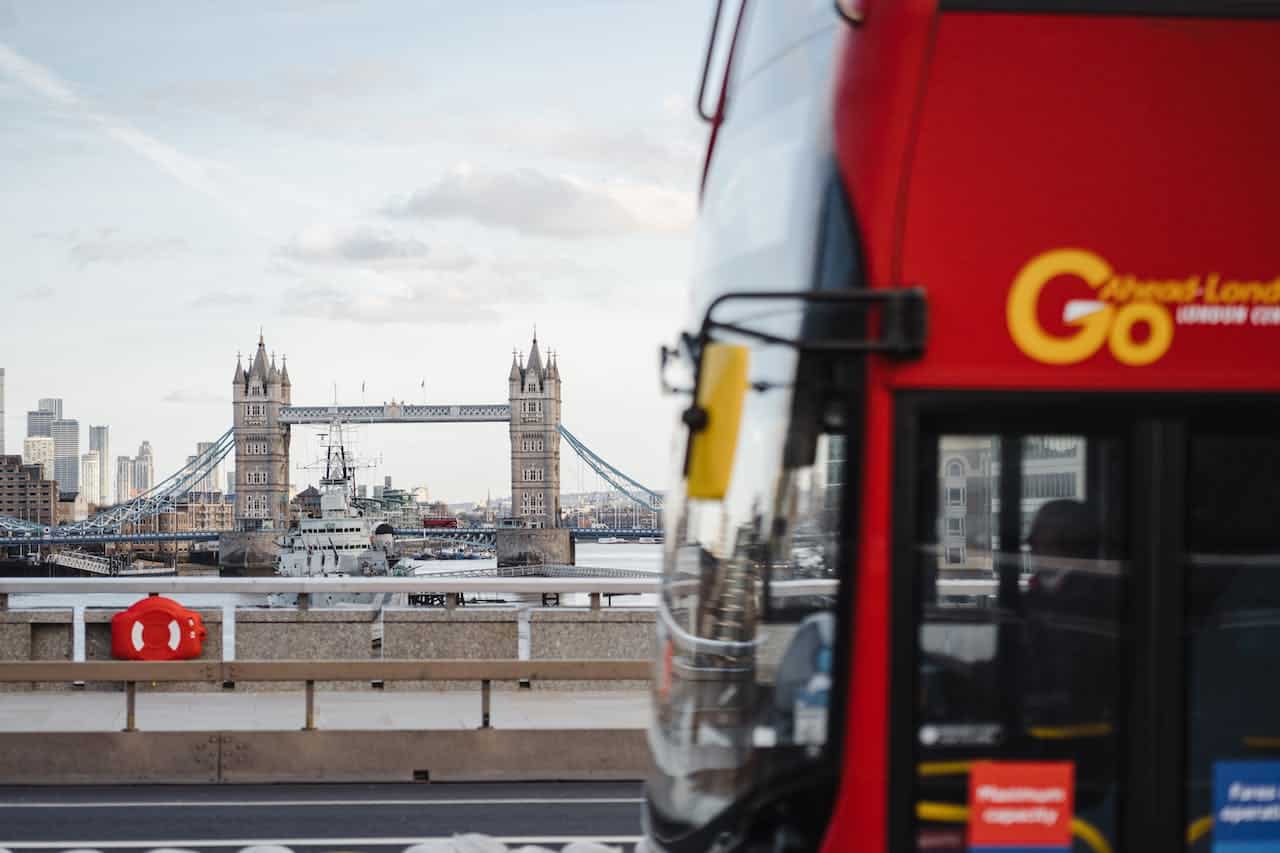
How to Start a Small Bus Transport Business
The small bus transport business is an integral cog in the wheel of urban and interurban connectivity, often operating in the shadows of their larger counterparts but playing a pivotal role in daily commutes. These businesses typically serve niche markets, offering specialized transit options tailored to community needs or geographical peculiarities. The agility of small bus operations allows them to adapt routes and schedules to serve community events, corporate functions, or regular shuttle services for institutions. They act as crucial links for suburban and rural areas, connecting them to mainline transport services and providing a lifeline for communities that might otherwise be isolated.
In many cities and towns, small bus businesses bridge the gap between personal and public transport. They offer the flexibility and convenience of a private car with the cost-effectiveness and social interaction of public transport. Such services can range from school runs, which provide safe passage for children, to luxury coaches for tourists exploring off-the-beaten-track attractions. They can also include shuttle services for businesses or last-mile connectivity services for more extensive public transport networks.
Importance of a Business Plan
A robust business plan stands as a beacon that guides a small bus transport business through the tumultuous waters of the transport sector. It’s not merely a document, but a strategic blueprint that encompasses the mission, operational strategy, marketing plans, and financial forecasts of the business. Such a plan is critical not only for guiding the company internally but also for communicating its vision and potential to external stakeholders. It serves as a persuasive tool for attracting investors, securing loans, and forming partnerships.
The business plan is the narrative of the business, telling the story of where the company aims to go and how it plans to get there. It outlines the unique selling propositions of the services offered, the expertise of the management team, and the financial acumen that underpins the venture. By presenting a clear picture of the market analysis, strategy, and financial viability, the business plan acts as a compass for decision-making and a gauge for measuring progress against objectives.
Understanding the Transport Industry
Current market trends
Navigating the current market trends in the transport industry requires vigilance and adaptability. With a growing emphasis on sustainability, operators are increasingly investing in low-emission buses and exploring alternative fuels. Innovations in technology are offering small bus businesses tools to streamline their operations, from dynamic routing software to advanced booking and payment platforms. These trends not only reflect changing consumer expectations but also the industry’s response to broader societal shifts.
The industry is also facing a period of reconstruction post-pandemic, as patterns of work and travel have been irrevocably altered. Flexible and dynamic transport solutions that can respond to changing commuter volumes and patterns are becoming the new standard. Small bus businesses are uniquely positioned to capitalize on this shift, given their inherent flexibility and capability to offer personalized services.
Different types of small bus transport business models
The ecosystem of small bus transport is diverse, encompassing a range of business models each with its distinctive characteristics. Contract-based models can provide steady income, establishing recurring business with schools, businesses, or government services. Demand-responsive transport is gaining traction, offering users a flexible and efficient alternative to fixed-route services, especially in low-density areas where traditional services may not be viable. Fixed-route services cater to consistent demand along key corridors and can provide reliable income if managed efficiently.
Each model serves different customer segments and requires distinct operational strategies. A contract service model demands punctuality and reliability, while demand-responsive services require sophisticated dispatch and booking systems. Fixed-route services need careful planning and marketing to ensure high ridership and route profitability.
Knowledge about regional and national laws, regulations, and permits
In the transport sector, compliance with laws and regulations is non-negotiable. It is imperative for small bus businesses to be well-versed in the regulatory environment, which includes obtaining the necessary permits, adhering to safety regulations, and meeting vehicle and driver standards. These laws ensure the safety of passengers and the general public, and they can vary greatly from one region to another.
Understanding these regulations is also crucial for planning the business model and operations. It affects everything from bus purchase decisions to hiring practices and route planning. Failure to comply can result in fines, legal action, or even the revocation of the right to operate, underscoring the importance of this knowledge in the foundational stages of business planning.

How to Start a Small Bus Transport Business:
Business plan creation.
In conceptualizing your business idea, it’s essential to identify the unique value proposition your small bus transport business will offer. This could mean identifying underserved routes, providing premium comfort in daily commutes, or creating bespoke services for tourists. The idea should stem from a clear understanding of potential customers’ pain points and seek to address them with innovative transport solutions.
A well-defined business concept not only clarifies the operational focus but also helps in branding and marketing efforts. It sets the foundation for all future strategies and decisions, anchoring the business in a clear purpose and direction. Whether it’s providing cost-effective daily transport for workers or luxurious coaches for tourists, the idea must resonate with the target market and meet specific needs.
Becoming familiar with the competition
In any business, knowledge of the competition is crucial, and in the small bus transport sector, it is doubly so. Understanding who your competitors are, their strengths and weaknesses, their market share, and their business models is vital. This intelligence informs your strategic decisions, from pricing to route planning, and can identify gaps in the market that your business could exploit.
A thorough analysis of competitors can reveal opportunities for differentiation. Perhaps there’s a gap in the quality of customer service offered or a potential for higher-end services that have not been tapped into. Knowledge of the competitive landscape helps in positioning your service in a way that appeals to customers looking for something that current options don’t provide.
Market research and target audience
Conducting thorough market research is critical in painting a detailed picture of the potential customer base. It allows you to understand the demographics, preferences, and behaviors of the population you intend to serve. This information is the cornerstone of developing effective marketing strategies and crafting services that resonate with your intended audience.
Identifying the target audience is not just about understanding who they are, but also where they need to go, their expectations for service, and their willingness to pay. This insight will inform everything from the frequency and timing of services to the choice of vehicles and onboard amenities. Market research ultimately ensures that the services provided align with what the market needs and wants, thus maximizing the potential for business success.
Pricing strategy and income projection
Developing a pricing strategy is a delicate balancing act that requires careful consideration of cost structures, competitive pricing, and perceived value. The goal is to find a sweet spot where prices are attractive enough to lure passengers away from other modes of transport, yet high enough to cover costs and deliver a profit. It’s a core aspect of the business model that affects demand, revenue, and overall financial health.
Income projections, based on the pricing strategy, are a vital part of the business plan. They are used to forecast future financial performance and are critical in securing funding from investors or lenders. These projections must be grounded in realistic assumptions about ridership, operational costs, and market growth. They provide a financial framework within which the business must operate, setting targets for revenue and identifying the path to profitability.
Building Your Own Fleet
- Choosing the right type of buses : Building an efficient and effective fleet starts with choosing the right type of buses. Key factors to consider include fuel efficiency, which impacts long-term operational costs, and seating capacity, which should align with your anticipated passenger volume. Maintenance costs are another crucial factor; lower maintenance needs can significantly reduce operating expenses over time. The type of service planned also dictates the choice of buses. For instance, city transit services may require different features compared to long-distance travel buses. You’ll need to balance budget constraints with these operational considerations to select the most appropriate buses for your service.
- Proper vehicle maintenance : Regular and systematic vehicle maintenance is non-negotiable in the transportation industry. Investing in preventive maintenance can significantly reduce the likelihood of costly repairs and unexpected breakdowns. Consistent maintenance ensures the buses remain in top condition, extending their useful life and guaranteeing the safety and comfort of passengers. A well-maintained fleet also reflects positively on your business’s reputation for reliability and safety.
- Acquisition of necessary equipment : Equipping your buses with necessary safety features is both a legal requirement and a moral imperative. This includes fitting each bus with fire extinguishers, visible and functional emergency exit signs, and comprehensive first aid kits. Beyond safety equipment, consider the comfort of your passengers, especially for longer journeys. Features like air conditioning, entertainment systems, and Wi-Fi can significantly enhance passenger experience. The choice of these additional features often depends on your customer demographic and the nature of your service.
Designing Operational Procedure
- Hiring and training staff : The efficiency and quality of your service heavily depend on your staff. Hiring competent employees and investing in their continuous training are crucial. Regular training ensures that your team stays up-to-date with the latest industry regulations, safety protocols, and technological advancements. It also plays a vital role in boosting employee morale and job satisfaction, which in turn can improve the quality of service provided to passengers.
- Creating a schedule and routes : Effective route planning and scheduling are the backbones of a successful transport business. Developing optimized routes and schedules requires a deep understanding of your target market, including the peak travel times and preferred destinations of your passengers. Efficient scheduling ensures that your service is both convenient for users and cost-effective for your business.
- Preparation for special needs passengers : Inclusivity is key in public transport services. It’s essential to make provisions for passengers with special needs. This includes ensuring wheelchair accessibility, incorporating braille signs for the visually impaired, and providing dedicated seating areas. Catering to special needs passengers not only broadens your potential customer base but also demonstrates a commitment to community service and accessibility.

Marketing and Advertising Your Business
- Branding your business : Creating a strong and recognizable brand is vital in setting your transport service apart from competitors. A good brand reflects your business’s values, promises, and identity. It should resonate with your target audience and create a lasting impression. Investing in a professional logo, distinctive bus designs, and consistent branding across all touchpoints can significantly enhance brand recognition.
- Developing a marketing strategy : An effective marketing strategy combines multiple channels to reach and engage with your target audience. This could include traditional marketing methods like print and broadcast media, as well as digital marketing. Tailor your marketing efforts to align with the preferences and behaviors of your target market. Analyzing market trends and customer feedback can help refine your strategy for maximum impact.
- Using social media and other online platforms for advertising : In today’s digital age, social media and online platforms are crucial for reaching out to customers. These platforms offer a cost-effective way to increase visibility, interact with passengers, and build a community around your brand. Leveraging social media for targeted advertising campaigns, engaging content, and customer service can drive significant growth and brand loyalty. In addition, having an intuitive and informative website can further enhance your online presence, providing a platform for customers to access information, book tickets, and provide feedback.
Ensuring Financial Stability and Growth
Financial stability is the bedrock on which successful businesses are built. Especially in the transport sector, where margins can often be thin, and competition is stiff, ensuring that you manage your resources optimally is crucial.
Managing your operating costs
One of the primary avenues to ensure profitability is to keep a tight leash on operating costs. Every penny saved on unnecessary expenses directly contributes to your bottom line. A diligent and consistent evaluation of operational expenditures can help identify inefficiencies or areas where costs can be trimmed without affecting performance. For instance, renegotiating vendor contracts, exploring fuel-efficient routes, or investing in preventive maintenance to reduce breakdowns can lead to significant savings in the long run.
Expanding your services
In a dynamic marketplace, businesses that adapt and expand often fare better than those that remain static. Diversifying the services your fleet provides not only taps into new customer segments but can also hedge against downturns in any single service area. This might involve moving into specialized transportation sectors, adding value-added services like logistics management, or tapping into emerging markets. As you diversify, it’s essential to ensure that the quality of service remains consistent, as this will be vital in building and retaining a loyal customer base.
Investment opportunities and financial management
To secure a future of sustained growth, a transport business must do more than just manage its day-to-day finances. A forward-looking financial strategy involves recognizing and seizing investment opportunities. This could mean expanding the fleet, exploring technological upgrades, or even acquisitions and mergers. Having a clear understanding of the transport business cycle, along with an agile approach to financial management, can provide the liquidity and flexibility needed to capitalize on these opportunities when they arise.
Handling Possible Challenges and Risks
The transport business, while lucrative, comes with its fair share of challenges. Being forearmed with knowledge and strategies can be the difference between weathering these challenges and being overwhelmed by them.
Dealing with insurance
The potential for damages and accidents makes insurance a non-negotiable aspect of the transport business. While third-party insurance is mandatory, it’s often prudent to consider comprehensive insurance. This can cover damages to your own vehicles, theft, or even loss of income due to disruptions. Periodically reviewing and updating your insurance cover, based on the evolving needs and risks of your business, ensures you remain adequately protected without paying for unnecessary coverage.
Addressing common possible pitfalls
The road to success in the transport industry is not without its bumps. Fluctuating fuel prices can erode profitability. Mechanical breakdowns can lead to service disruptions, unhappy clients, and potential loss of business. Accidents, besides being potential financial drains, can also harm the company’s reputation. And then there are the ever-present regulatory changes, which can necessitate expensive compliance measures. Being vigilant, staying updated on industry trends, and investing in training and maintenance can mitigate many of these risks.
Contingency planning
Every seasoned business owner knows that despite the best precautions, unforeseen disruptions can and will occur. It’s not enough to hope for the best; one must also plan for the worst. This involves identifying potential threats to your business and having a blueprint to navigate them. Whether it’s a sudden spike in fuel prices, loss of a major client, or even global events like economic downturns, a robust contingency plan ensures that the business remains resilient. This involves financial provisions, backup vendors, alternate routes, and even crisis communication strategies to keep stakeholders informed. Preparedness is, after all, half the battle won.
Sign in to your account
Username or Email Address
Remember Me

Transportation Business Plan Template
Written by Dave Lavinsky
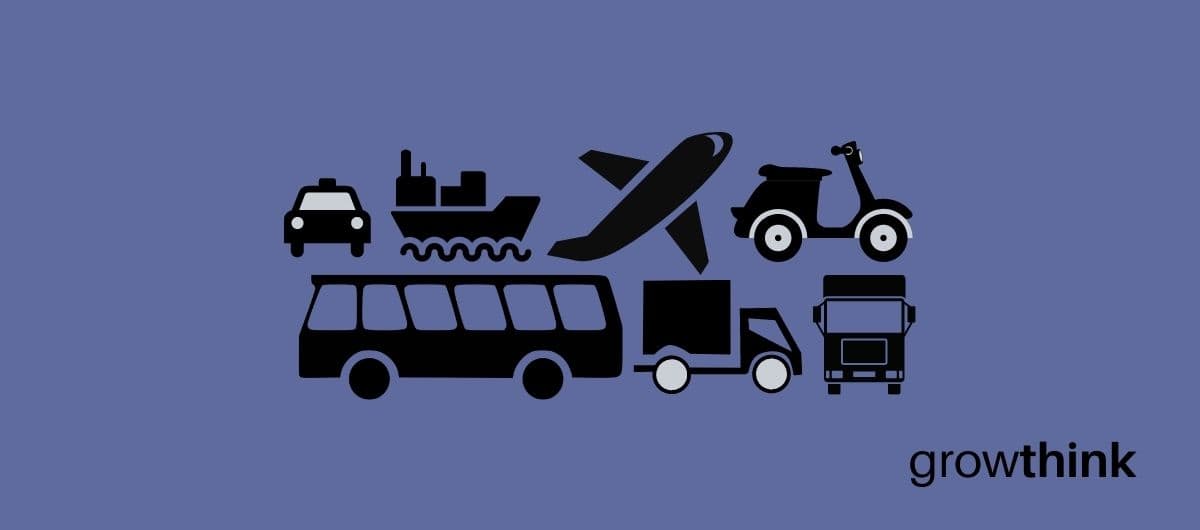
Transportation Business Plan
Over the past 20+ years, we have helped over 1,000 entrepreneurs and business owners create business plans to start and grow their transportation businesses. On this page, we will first give you some background information with regards to the importance of business planning. We will then go through a transportation business plan template step-by-step so you can create your plan today.
Download our Ultimate Business Plan Template here >
What is a Transportation Business Plan?
A business plan provides a snapshot of your transportation business as it stands today, and lays out your growth plan for the next five years. It explains your business goals and your strategy for reaching them. It also includes market research to support your plans.
Why You Need a Business Plan for a Transportation Business
If you’re looking to start a transportation business, or grow your existing transportation business, you need a business plan. A business plan will help you raise funding, if needed, and plan out the growth of your transportation business in order to improve your chances of success. Your business plan is a living document that should be updated annually as your company grows and changes.
Sources of Funding for Transportation Companies
With regards to funding, the main sources of funding for a transportation business are personal savings, credit cards, bank loans and angel investors. With regards to bank loans, banks will want to review your business plan and gain confidence that you will be able to repay your loan and interest. To acquire this confidence, the loan officer will not only want to confirm that your financials are reasonable, but they will also want to see a professional plan. Such a plan will give them the confidence that you can successfully and professionally operate a business. Personal savings and bank loans are the most common funding paths for transportation businesses.
Finish Your Business Plan Today!
How to Write a Business Plan for a Transportation Company
If you want to start a transportation business or expand your current one, you need a business plan. Below we detail what you should include in each section of your own business plan:
Executive Summary
Your executive summary provides an introduction to your business plan, but it is normally the last section you write because it provides a summary of each key section of your plan.
The goal of your Executive Summary is to quickly engage the reader. Explain to them the type of transportation business you are operating and the status. For example, are you a startup, do you have a transportation business that you would like to grow, or are you operating transportation businesses in multiple markets?
Next, provide an overview of each of the subsequent sections of your plan. For example, give a brief overview of the transportation industry. Discuss the type of transportation business you are operating. Detail your direct competitors. Give an overview of your target customers. Provide a snapshot of your marketing plan. Identify the key members of your team. And offer an overview of your financial plan.
Company Analysis
In your company analysis, you will detail the type of transportation business you are operating.
For example, you might operate one of the following types of transportation businesses:
- Moving Van Transportation : this type of transportation company specializes in large vans or small fleet trucks to move individuals to a new home. Larger companies are able to move the family or individual to a different country.
- Medical Transportation: this type of transportation company specializes in the transportation of medical supplies and/or devices and equipment.
- Taxi Company: this type of transportation company focuses on individuals needing to get to different locations. These trips are often short and within the same city or neighborhood. Many individuals utilize taxi companies for pickup or dropoff from the airport.
In addition to explaining the type of transportation business you will operate, the Company Analysis section of your business plan needs to provide background on the business.
Include answers to question such as:
- When and why did you start the business?
- What milestones have you achieved to date? Milestones could include the number of clients served, number of positive reviews, reaching X amount of clients served, etc.
- Your legal structure. Are you incorporated as an S-Corp? An LLC? A sole proprietorship? Explain your legal structure here.
Industry Analysis
In your industry analysis, you need to provide an overview of the transportation industry.
While this may seem unnecessary, it serves multiple purposes.
First, researching the transportation industry educates you. It helps you understand the market in which you are operating.
Secondly, market research can improve your strategy, particularly if your research identifies market trends.
The third reason for market research is to prove to readers that you are an expert in your industry. By conducting the research and presenting it in your plan, you achieve just that.
The following questions should be answered in the industry analysis section:
- How big is the transportation industry (in dollars)?
- Is the market declining or increasing?
- Who are the key competitors in the market?
- Who are the key suppliers in the market?
- What trends are affecting the industry?
- What is the industry’s growth forecast over the next 5 – 10 years?
- What is the relevant market size? That is, how big is the potential market for your transportation business? You can extrapolate such a figure by assessing the size of the market in the entire country and then applying that figure to your local population.
Customer Analysis
The customer analysis section must detail the customers you serve and/or expect to serve.
The following are examples of customer segments:individuals, seniors, families, and companies that need to transport their products.
As you can imagine, the customer segment(s) you choose will have a great impact on the type of transportation business you operate. Clearly, companies would respond to different marketing promotions than individuals, for example.
Try to break out your target customers in terms of their demographic and psychographic profiles. With regards to demographics, include a discussion of the ages, genders, locations and income levels of the customers you seek to serve.
Psychographic profiles explain the wants and needs of your target customers. The more you can understand and define these needs, the better you will do in attracting and retaining your customers.
Finish Your Transportation Business Plan in 1 Day!
Don’t you wish there was a faster, easier way to finish your business plan?
With Growthink’s Ultimate Business Plan Template you can finish your plan in just 8 hours or less!
Competitive Analysis
Your competitive analysis should identify the indirect and direct competitors your business faces and then focus on the latter.
Direct competitors are other transportation businesses.
Indirect competitors are other options that customers have to purchase from that aren’t direct competitors. This includes transportation companies such as limousines, bicycle services, car rental companies, etc.
With regards to direct competition, you want to describe the other transportation businesses with which you compete. Most likely, your direct competitors will be transportation businesses located very close to your location.

For each such competitor, provide an overview of their businesses and document their strengths and weaknesses. Unless you once worked at your competitors’ businesses, it will be impossible to know everything about them. But you should be able to find out key things about them such as:
- What types of vehicles do they operate?
- What areas do they serve?
- What type of transportation company are they?
- What is their pricing (premium, low, etc.)?
- What are they good at?
- What are their weaknesses?
With regards to the last two questions, think about your answers from the customers’ perspective. And don’t be afraid to ask your competitors’ customers what they like most and least about them.
The final part of your competitive analysis section is to document your areas of competitive advantage. For example:
- Are your vehicles more fully-equipped than the competition?
- Will you provide transportation services that your competitors don’t offer?
- Will you provide faster delivery time?
- Will you provide better customer service?
- Will you offer better pricing?
Think about ways you will outperform your competition and document them in this section of your plan.
Marketing Plan
Traditionally, a marketing plan includes the four P’s: Product, Price, Place, and Promotion. For a transportation company, your marketing plan should include the following:
Product : In the product section, you should reiterate the type of transportation company that you documented in your Company Analysis. Then, detail the specific products you will be offering. For example, in addition to transportation services, will you provide GPS tracking, 24/7/365 service, client communication, and any other services?
Price : Document the prices you will offer and how they compare to your competitors. Essentially in the product and price sub-sections of your marketing plan, you are presenting the services you offer and their prices.
Place : Place refers to the location of your transportation company. Document your location and mention how the location will impact your success. For example, is your transportation business located near a warehouse district, an office complex, an urban setting, or a busy neighborhood, etc. Discuss how your location might be the ideal location for your customers.
Promotions : The final part of your transportation marketing plan is the promotions section. Here you will document how you will drive customers to your location(s). The following are some promotional methods you might consider:
- Advertising in local papers and magazines
- Commercials
- Social media marketing
- Local radio advertising
Operations Plan
While the earlier sections of your business plan explained your goals, your operations plan describes how you will meet them. Your operations plan should have two distinct sections as follows.
Everyday short-term processes include all of the tasks involved in running your transportation business, including cleaning the vehicle, any necessary mechanical needs the vehicle may require, fueling the vehicle, and informing clients of location and status updates.
Long-term goals are the milestones you hope to achieve. These could include the dates when you expect to obtain your XXth client, or when you hope to reach $X in revenue. It could also be when you expect to expand your transportation business to a new location.
Management Team
To demonstrate your transportation business’ ability to succeed, a strong management team is essential. Highlight your key players’ backgrounds, emphasizing those skills and experiences that prove their ability to grow a company.
Ideally you and/or your team members have direct experience in managing transportation businesses. If so, highlight this experience and expertise. But also highlight any experience that you think will help your business succeed.
If your team is lacking, consider assembling an advisory board. An advisory board would include 2 to 8 individuals who would act like mentors to your business. They would help answer questions and provide strategic guidance. If needed, look for advisory board members with experience in managing a transportation business or is connected to a wide network of professional associations.
Financial Plan
Your financial plan should include your 5-year financial statement broken out both monthly or quarterly for the first year and then annually. Your financial statements include your income statement, balance sheet and cash flow statements.
Income Statement : an income statement is more commonly called a Profit and Loss statement or P&L. It shows your revenues and then subtracts your costs to show whether you turned a profit or not.
In developing your income statement, you need to devise assumptions. For example, will you take on one new client at a time or multiple new clients with multiple vehicles and drivers ? And will sales grow by 2% or 10% per year? As you can imagine, your choice of assumptions will greatly impact the financial forecasts for your business. As much as possible, conduct research to try to root your assumptions in reality.
Balance Sheets : Balance sheets show your assets and liabilities. While balance sheets can include much information, try to simplify them to the key items you need to know about. For instance, if you spend $50,000 on building out your transportation business, this will not give you immediate profits. Rather it is an asset that will hopefully help you generate profits for years to come. Likewise, if a bank writes you a check for $50,000, you don’t need to pay it back immediately. Rather, that is a liability you will pay back over time.
Cash Flow Statement : Your cash flow statement will help determine how much money you need to start or grow your business, and make sure you never run out of money. What most entrepreneurs and business owners don’t realize is that you can turn a profit but run out of money and go bankrupt.
In developing your Income Statement and Balance Sheets be sure to include several of the key costs needed in starting or growing a transportation business:
- Cost of vehicles
- Cost of fuel and transportation overhead
- Payroll or salaries paid to staff
- Business insurance
- Taxes and permits
- Legal expenses
Attach your full financial projections in the appendix of your plan along with any supporting documents that make your plan more compelling. For example, you might include your vehicle lease or cost, types of customer you will be targeting, and the areas your transportation business will serve.
Putting together a business plan for your transportation business is a worthwhile endeavor. If you follow the template above, by the time you are done, you will truly be an expert. You will really understand the transportation industry, your competition, and your customers. You will have developed a marketing plan and will really understand what it takes to launch and grow a successful transportation business.
Don’t you wish there was a faster, easier way to finish your Transportation business plan?
OR, Let Us Develop Your Plan For You
Since 1999, Growthink has developed business plans for thousands of companies who have gone on to achieve tremendous success. See how Growthink’s business plan advisors can give you a winning business plan.
Other Helpful Business Plan Articles & Templates


IMAGES
VIDEO
COMMENTS
Pre-Written Minibus Business Plan (PDF, Word And Excel): Comprehensive Version, Short Funding/Bank Loan Version and Automated Financial Statements. For an in-depth analysis of the minibus public transport business, we encourage you to purchase our well-researched and comprehensive minibus transport business plan.
Create a winning transportation business plan to ensure efficiency, growth, and success in freight, logistics, or passenger services. Get started with expert strategies.
Jumpstart your transportation venture with our comprehensive business plan example! Get a free, detailed roadmap to success, tailored for transportation startups. Download now and accelerate your journey to profitability!
The document is a business plan for starting a minibus transportation business. It outlines the mission, vision, objectives, and keys to success of owning a minibus business. It also describes the business operations including insurance requirements, management structure, and operational strategy.
How to Start a Small Bus Transport Business: Business Plan Creation. In conceptualizing your business idea, it’s essential to identify the unique value proposition your small bus transport business will offer. This could mean identifying underserved routes, providing premium comfort in daily commutes, or creating bespoke services for tourists.
A business plan provides a snapshot of your transportation business as it stands today, and lays out your growth plan for the next five years. It explains your business goals and your strategy for reaching them. It also includes market research to support your plans.